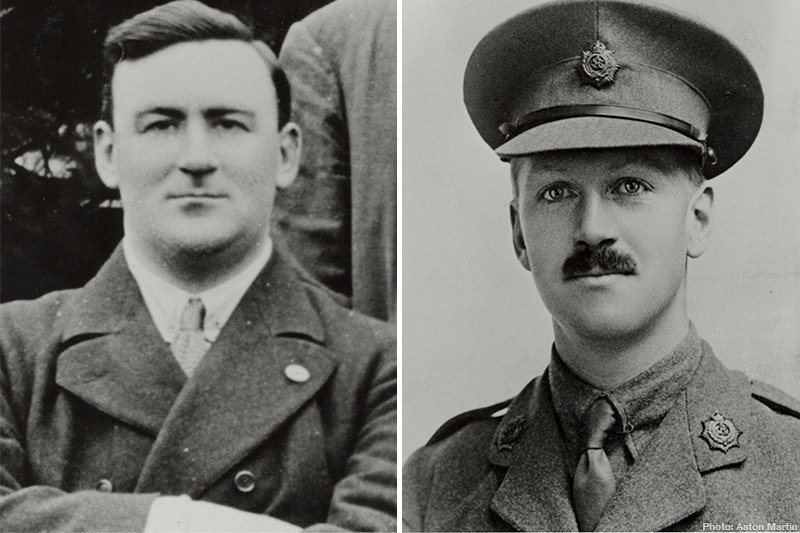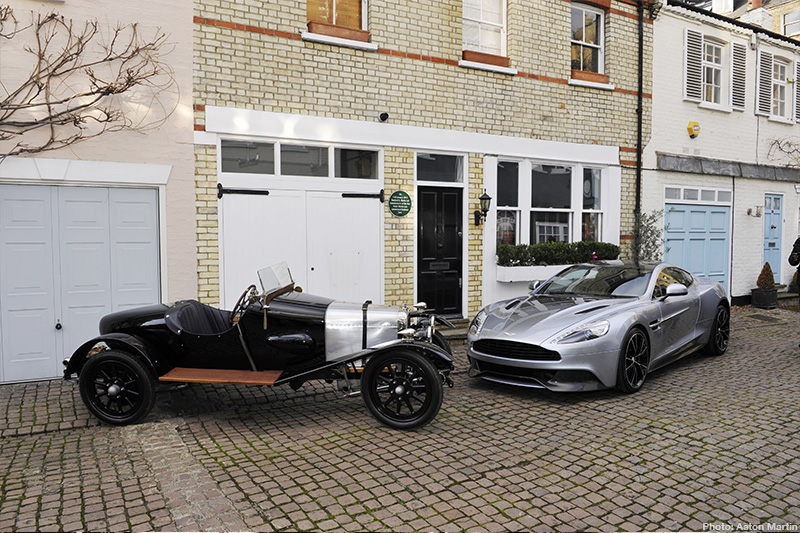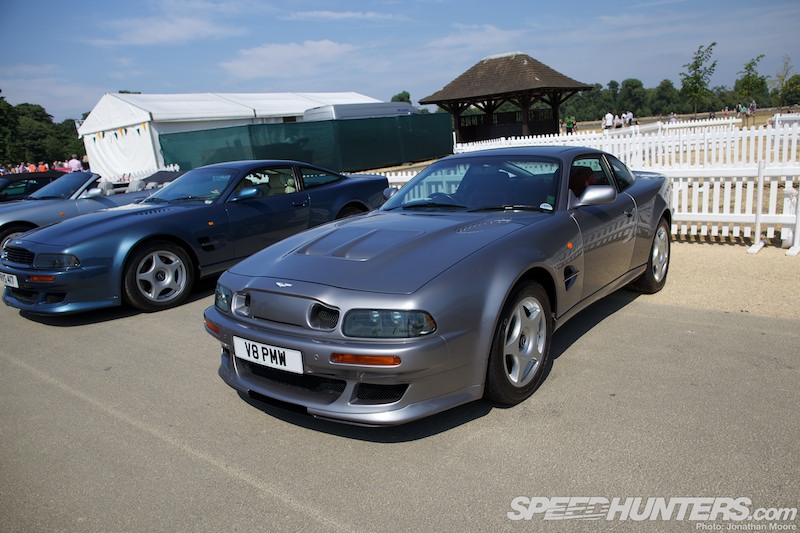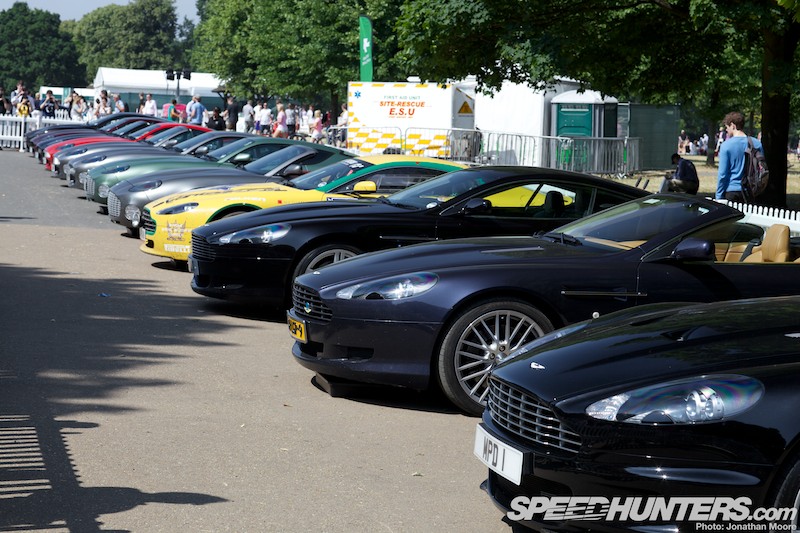
It’s true that very few car companies have simple histories. The complex nature of what is involved in producing a car in any era – the risks, the market, the technology – means that passion and politics are often as important a part of the story as any discussion of pure commercial success or failure. But Aston Martin have experienced a particularly turbulent time over the first hundred years of their existence. Describing things as having up and downs barely scratches the surface of what’s happened in the tumultuous century since Robert Bamford and Lionel Martin decided to build a racing car in their workshop in a modest suburb of West London.

There are only a handful of car companies who have been in continuous existence for so long, but few others are either still as fiercely independent or as exclusive as Aston Martin. Yet somehow Aston Martin has a special place in the hearts of those who love cars. They’re the most inclusive of exclusive brands. There’s a disarming honesty and integrity about their cars: people in the street tend to have a very different and positive reaction to an Aston Martin compared to many other supercars.

Aston Martin have gone through five distinct periods, each defined by the strength of the personalities involved as much as the very individual styling of the cars that fall within each time frame. Even when owned by a major corporation, it was still an individual who championed Aston Martin’s cause, though that has also always been part of the problem.

But strangely, the dysfunctional periods and crises which have rocked the company from time to time seem only to have helped Aston Martin manage that shift between styles and allowed the company to continue to evolve, whilst always leaving the core character and ethos intact. A regeneration each time, from which Aston Martin has metamorphosed into its next form.

Even talking to senior Aston personnel now, there’s usually a wry smile on their face when discussing the history of Aston Martin – though never in the way that you might expect. The more challenging periods are described almost liked a difficult but loved relative: the family wouldn’t be the same without them. Every experience makes up the whole. Thankfully Aston Martin have been on an upward curve for the last decade: it’s a period that has seen an explosion in production, with the vast majority of the firm’s 65,000 cars produced in the last ten years of its century-long existence. By 1984 they had still only built 10,000 cars, for instance.

By their own admission they’re still capable of mistakes, and the world economic situation means that nothing is a given. But you get the feeling that Aston Martin will somehow always get through, whilst still producing utterly beautiful, individualistic sportscars. It’s the human element that stands them apart in a crowded marketplace and helps them engender such loyalty and enthusiasm.

It’s always been that way: Aston’s history has always been about people as much as cars. It’s much more than just a pair of wings on the nose of a sportscar.

Having paired up as Bamford & Martin (Robert, left, and Lionel, right) to sell Singer cars, the first Aston Martin was built in 1914: a hillclimb special made for Martin to compete on the Aston Hill course in the south-east of the UK – the hill is still used now for mountain bike races. It’s always difficult to tell which was more important: the commercial or competitive aspect. That’s a question that could still be asked over any given period in Aston Martin’s history…

The quiet mews street in Kensington now has a green plaque commemorating the birthplace of Aston Martin. Although Bamford left the company in 1920, funding from Count Louis Zborowski (whose racing exploits inspired the novel Chitty Chitty Bang Bang) revitalised the company. Of course, this wouldn’t be the first time an ailing Aston Martin depended on a wealthy patron to keep going.

The company went from strength to strength, moving onto the international arena by competing in the 1922 French Grand Prix and setting multiple records at the nearby Brooklands speedway. A 1923 Aston Martin, Razor Blade, is kept in the Brooklands museum, which was based on one of the GP chassis. The narrow track body was optimised for speed, and the louvres on the nose controlled by the driver to alter airflow to the radiator.

This is the oldest surviving Aston Martin: an A3 from 1922 and one of just three cars produced that year. Typically, it served as both a road car and racer. Barely 60 Aston Martins were built under the Bamford & Martin name between 1914 and 1925 when the company was again declared bankrupt. Zborowski had been killed in a race at Monza, and Martin was forced to relinquish control.

A consortium of investors dived in to save the firm, which included Augustus Bertelli. The newly renamed Aston Martin Motors would enjoy a decade of glory, with some iconic cars produced under the new management: the Series II, Le Mans and Ulster racer. Around 300 cars were built in this period, with AM racers carrying the unfamiliar red of Bertelli’s Italy from 1935 for a couple of years. But then yet more financial problems reared their head in 1932, and ownership changed hands a further two times before the onset of the Second World War. Production in the Feltham factory turned from cars to aircraft parts and Aston Martin could have been finished but for the intervention of one man…

The next phase of the Aston Martin story is seen as the defining era of the company, which is hard to argue. In ’47, tractor magnate David Brown swooped on the firm (an advert in The Times offered for sale ‘A High Quality Motor Business’), also snapping up Lagonda for its Bentley-designed engine technology and the Tickford coachbuilding plant in Newport Pagnell. This was the beginning of a quarter century of ownership that would cement the foundations for Aston success both on and off the track. It was considered by Brown as a hobby – though a serious one – and it was one that would never turn a profit.

The origins lay with the Aston Martin Atom prototype, developed in 1939. It’s regarded as perhaps the first ever concept car and is apparently the car that made David Brown buy Aston Martin.

The first car to emerge from the David Brown concern was the 2-Litre Sports (retrospectively named DB1) in 1948. Based on the Atom platform, of course the Sports was raced as a way of proving it: it won the 1948 Spa 24 Hours outright, and just 15 examples were built. As with a number of the cars pictured here, it reminded me just what a special event the Aston Martin Centenary Celebration in Hyde Park had been, with so many unique or incredibly rare cars brought out by their owners.

Production increased dramatically with the firm’s first mainstream sportscar: the graceful DB2. The first three Lagonda-powered prototypes were shipped straight to Le Mans; this is the fourth car, which belonged to David Brown himself. With its long and tapering nose, it’s only the narrow throwback wire-wheels that jack the car up and give it a more jarring look– on smaller, closer fitting wheels this would have been stunning.

410 DB2s were built between 1950 and ’53. DB not only gave the company its focus on sports GTs but also a design language in the grill shape and a naming prefix for cars which lives on to this day. The Vantage brand was also introduced for the DB2, defining tuned and high performance variants from then on.

The DB2/4 and DB MkIII evolutions followed, each building on the success of the last model. The lines softened and became even more curvaceous. A timeless icon was on the horizon: the DB4-6 series. But Le Mans called again in the meantime, for Aston Martin’s most glorious run at the classic race.

Following those hillclimbing origins and successes at Brooklands and Le Mans in the ’20s and ’30s, Aston Martin had been throwing successive cars at Le Mans with some success in the late ’40s and early ’50s. The DB2 was consistently winning its class, and the DB3S dedicated race car scored three second places at the Le Mans 24 Hours between ’55 and ’58. But it was the DBR1 that defines Aston Martin racers of the ’50s. Possibly the most beautiful racing car of the period, – ever? – when combined with the definitive team manager of the era, John Wyer, the DBR1 quickly evolved from a fast but fragile racer into a world-beater. With a stellar driver line-up that included Stirling Moss and Caroll Shelby, Aston Martin finished first and second at Le Mans in ’59 and claimed victory in that year’s World Sportscar Championship.

On the road, in 1958 it was the DB4 that really got things moving. Over a thousand were sold of the svelte coupé across five series variants, convertibles and GTs, and the DB4 was the first model to be put together at the famous Newport Pagnell factory. It used a Superleggara tube-frame construction designed by Italian firm Carrozzeria Touring under its gorgeous body and unsurprisingly caused a sensation when it was unveiled at the London Motor Show.

19 special edition DB4GT Zagatos were built between ’60 and ’63: these are now some of the most expensive and exclusive cars on the planet.

Even if not aware of Aston Martin, there are few people on the planet who don’t recognise a DB5. Introduced in 1963 as a refined version of the DB4, the car became the star of the third James Bond film, 1964’s Goldfinger, and captured the public’s imagination – and a relationship with the British spy that has been frequently rekindled in subsequent films.

Actually, I say that people recognise a DB5: the differences between a DB4 and DB5 were mostly under the bonnet, with a new aluminium engine and ZF gearbox. The only obvious external distinguishing feature is that the DB5 has raked-back headlights; the DB4’s extend from the bodywork.

Another 1,000 went out of the door, continuing solid sales, before the introduction of another evolution model in 1965: the DB6. Handling was improved and power upped with a new four-litre straight six, and the vertical Kammback tail helped stability. 1,788 were sold across two marks.

Incoming designer William Towns brought Aston Martin fully into the modern era with the angular, more muscular DBS of 1967, which again would be picked up by James Bond as his choice of automotive weapon in On Her Majesty’s Secret Service. But despite all this positivity on the outside, on the inside financial problems had once again overtaken the company: there’d been no profit for decades, and David Brown was finally forced to sell his ‘hobby’ company for the nominal sum of just £100 – an ignominious end to a glorious period.

The 1970s are often described for Aston Martin as simply being about survival: something that could be said about the entire British car industry of the time. New owners lasted barely three years before themselves going into receivership, though they did oversee the development of a design volte-face and the introduction of the blocky, American-influenced V8 in 1972.

This British take on a muscle car would front Aston for almost two decades, selling 2,360 cars across that period. The latest owners even managed to push the company back into profit, and at the same time introduced the up-gunned Vantage in ’77, which for a time was one of the fastest production cars in the world.

Despite the general national gloom of the time, this era also saw more risky ideas put into practice by Aston Martin. The extravagant Lagonda luxury four-door and Bulldog prototype were developed under their watch. The Lagonda took an extravagant leather interior and combined it with state of the art switchgear; the exterior carried forward the contemporary wedge-shaped design philosophy, and the car was loved and loathed in equal measures. It was hugely labour intensive to build, horribly expensive and appallingly unreliable: not a great combination. Still, it gave Aston Martin a cash-flow bump on its announcement in 1976, and the Lagonda struggled on in smaller and smaller production runs until the final Series 4 in 1989.

The Bulldog was a concept car developed in 1979, a test-bed for a proposed production run that never materialised. The theory was to prove Aston Martin was back in business: it was even launched near to the Aston hillclimb where Lionel Martin had raced all those years ago. K.901 achieved 191mph on a limited run, with the estimated potential top speed from the 5.3-litre twin-turbo V8 being 237mph; the dash was digital, and the rear view mirror was replaced by a TV monitor – all cutting edge stuff.

The upswing was given a further boost by the arrival of Victor Gauntlett in 1980, who bought into the company after bumping into the chairman of Aston Martin at a Brands Hatch race meeting celebrating the career of Stirling Moss. Gauntlett enthusiastically worked on further improving Aston’s fortunes. The Lagonda programme was extended, and the company awarded a Royal Warrant Of Appointment by the Prince Of Wales. The Tickford name was revived and used to develop and badge tuned versions of mainstream Ford and Rovers.

Racing was brought back onto the radar, with a Group C sports car programme of limited success. Although limited failure would be a better way of describing it, as it was battling in the face of overwhelming racing superpowers of the day like Porsche, Jaguar and Mercedes. Bond was back in an Aston as well, with Timothy Dalton installed in Gauntlett’s own pre-production Vantage on celluloid.

But again, despite all this positivity the long-term future of Aston Martin couldn’t be guaranteed. After a meeting with Ford’s Walter Hayes, a shareholding was sold to the US giant in 1987. The first new model Aston Martin in 18 years, the high-backed Virage, was launched in 1989, and not long afterwards Ford took over complete control.

The Virage was an excuse to beat even the thuggish power of the previous generation V8 special editions; the Vantage V600 and Le Mans editions that followed introduced even more aggressive styling to match the 600hp of V8 under the bonnet.

In a period where the monstrously big automotive conglomerates ruled the earth and were hoovering up all the minnows, Ford’s partnership was the only way for Aston Martin to survive the impending new century. They later headed up Ford’s new Premier Automotive Group, and the DB7 was born in 1994 from a leftover Jaguar project. It was no coincidence that they took up the naming from the last major car of the David Brown era: this was a conscious decision to rekindle the heritage of the brand in both style and name.

The benefits of being part of such a large group were obvious though: production numbers went vertical from previous figures, and more than 7,000 DB7s were sold. A V12 Vantage version beefed up the original six-cylinder and added lamp clusters styled on the Project racers of the 1960s.

But the new flagship model, the V12 Vanquish of 2001, showed the promise of what lay ahead and bridged the gap from the solid DB7 to the exciting new DB9. Its bonded aluminium chassis (no pun intended, naturally…) and powertrain proved a hit, and 2,500 were sold. This is the unique ‘Copper Kettle’ Vanquish S, produced in 2007 with a bespoke glass roof.
The original Tickford Street plant was finally closed in 2007 when the last Vanquish rolled off the production line, with manufacturing having gradually moved over to the new high tech plant at Gaydon from 2003. Tickford Street turned into the Heritage Works facility, which I’ll be looking at tomorrow. Engine production for both the V8 and V12 was centralised at the old Ford works in Cologne as the Aston Martin Engine Plant: however, this deal has just ended, and a new agreement struck with Mercedes AMG for future powerplants.

As soon as Aston Martin show signs of success, they’ve always gone racing – and it had often been the expense of exactly that which led to a swift demise shortly afterward. But this time the new DB9 was developed into a race car with the expert partners of David Richards’ Prodrive team: racing with passion and pragmatism seemed to be their mantra this time.

The ‘budget’ V8 Vantage model completed the line-up in 2005: as was tradition, the car was put out to race before hitting the street, competing in and finishing the 2006 Nürburgring 24 Hours.

A (hopefully) final financial problem intervened in the mid decade, though thankfully this time of the parent company and not Aston Martin: it was the huge corporation itself that having a cash-flow crisis, and the decision was taken to sell of several of its divisions to raise money. Richards put together a consortium of investors to take majority control, and just as almost 100 years ago Aston Martin was righted thanks to the passion of wealthy patrons.

Since then, there’s been further aggressive expansion and diversification in the shape of the Rapide luxury saloon, complementing Cygnet city car and One-77 hypercar alongside more typical Aston GT fare of Virage, V12 Zagato and V12 Vantage – though all are fundamentally Aston Martin through and through.

Heritage and history have always been recognised as being inherently important to Aston Martin. Partnerships tend to last – like the Zagato collaborations that have continued for over 50 years – and then there’s that tradition of racing, a part of Aston Martin’s DNA from the moment the company was born, and as mentioned, something often pursued to a destructive level.

And so the story continues, and plenty more chapters are likely to be written over the coming decades. Aston Martin is always a company worth celebrating: the fact it’s a hundred years old is just a good excuse. Here’s to the next century!
Jonathan Moore
Instagram: speedhunters_jonathan
jonathan@speedhunters.com
Aston Martin theme on Speedhunters
More Aston Martin stories on Speedhunters





